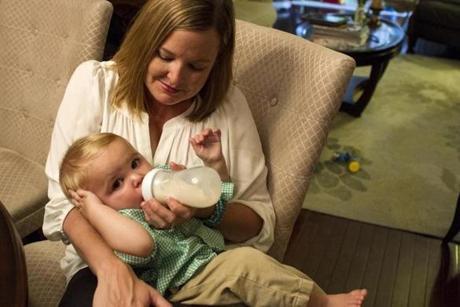
Boston Globe: Stacie Chapman’s heart skipped when she answered the phone at home and her doctor — rather than a nurse — was on the line. More worrisome was the doctor’s gentle tone as she asked, “Where are you?”
On that spring day in 2013, Dr. Jayme Sloan had bad news for Chapman, who was nearly three months pregnant. Her unborn child had tested positive for Edwards syndrome, a genetic condition associated with severe birth defects. If her baby — a boy, the screening test had shown — was born alive, he probably would not live long.
Sloan explained that the test — MaterniT21 PLUS — has a 99 percent detection rate. Though Sloan offered additional testing to confirm the result, a distraught Chapman said she wanted to terminate the pregnancy immediately.
What she — and the doctor — did not understand, Chapman’s medical records indicate, was that there was a good chance her screening result was wrong. There is, it turns out, a huge and crucial difference between a test that can detect a potential problem and one reliable enough to diagnose a life-threatening condition for certain. The screening test only does the first.
Sparked by the sequencing of the human genome a decade ago, a new generation of prenatal screening tests, including MaterniT21, has exploded onto the market in the past three years. The unregulated screens claim to detect with near-perfect accuracy the risk that a fetus may have Down or Edwards syndromes, and a growing list of other chromosomal abnormalities.

Screening can determine risk for health problems, but only diagnostic tests can prove with certainty that a disease is present. Hundreds of thousands of women in early pregnancy have taken these tests — through a simple blood draw in the doctor’s office — and studies show them to perform far better than traditional blood tests and ultrasound screening.
But a three-month examination by the New England Center for Investigative Reporting has found that companies are overselling the accuracy of their tests and doing little to educate expecting parents or their doctors about the significant risks of false alarms.
Two recent industry-funded studies show that test results indicating a fetus is at high risk for a chromosomal condition can be a false alarm half of the time. And the rate of false alarms goes up the more rare the condition, such as Trisomy 13, which almost always causes death.
Companies selling the most popular of these screens do not make it clear enough to patients and doctors that the results of their tests are not reliable enough to make a diagnosis.
California-based Sequenom Inc., for instance, promises on its web page that its MaterniT21 blood test provides “simple, clear results.” Only far down below does Sequenom disclose that “no test is perfect” and that theirs can produce erroneous results “in rare cases.”
Now, evidence is building that some women are terminating pregnancies based on the screening tests alone. A recent study by another California-based testing company, Natera Inc., which offers a screen called Panorama, found that 6.2 percent of women who received test results showing their fetus at high risk for a chromosomal condition terminated pregnancies without getting a diagnostic test such as an amniocentesis.
And at Stanford University, there have been at least three cases of women aborting healthy fetuses that had received a high-risk screen result. “The worry is women are terminating without really knowing if [the initial test result] is true or not,” said Athena Cherry, professor of pathology at the Stanford University School of Medicine, whose lab examined the cells of the healthy aborted fetuses.
In one of the three Stanford cases, the woman actually obtained a confirmatory test and was told the fetus was fine, but aborted anyway because of her faith in the screening company’s accuracy claims. “She felt it couldn’t be wrong,” Cherry said.
Companies that sell the screens stand behind their tests, saying they provide much more reliable assurance for expecting mothers than earlier screens. Some say their research focused first on how to accurately identify fetuses with potential genetic defects and only recently have they been able to get enough data to understand how often positive tests are wrong.
The article is rather lengthy, read the rest here.
More about Stacie Chapman’s story:
But Stacie Chapman knew nothing about these uncertainties when Dr. Sloan told her that her unborn son had screened positive for a genetic condition that was largely incompatible with life.
Hysterical with grief when she hung up, Chapman phoned her husband at a Las Vegas airport on his way home from a business trip. Together, sobbing, they concluded that their son would only suffer if he survived birth. So, that afternoon, Sloan put her in touch with a nurse who found a doctor who could do the termination the next morning.
Chapman spent the afternoon Googling the horrors of Edwards syndrome, with its heart defects, development delays, and extraordinarily high mortality. She was steeling herself for the termination when Sloan called back, urging her to wait, according to Chapman’s medical record.
Chapman had a diagnostic test and learned her son did not have Edwards syndrome. A healthy Lincoln Samuel just turned 1 and has a wide smile that reminds Chapman of her recently deceased father.
However briefly considered, their decision to abort — informed by the MaterniT21’s advertised 99 percent detection statistic — haunts them to this day. “He is so perfect,’’ Chapman, 43, said, choking up as she watched her son play with a toy lamb. “I almost terminated him.”

Lauren Owens/NECIR
Stacie Chapman’s son was born healthy, despite the results of a prenatal screening. But Stacie Chapman remains conflicted about the doctor’s first call that set in motion the near termination of her pregnancy. Sloan did not stress that the test was just a screen that could be wrong, she recalled.
“I didn’t seek this test out — this test was offered to me by the doctor’s office. They should know how it performs,’’ Chapman said, adding that she would never have considered a pregnancy termination if she had better understood the odds that her result could be wrong.
A health professional involved in Chapman’s case who was not authorized by her employer to comment said Sloan initially was unaware that the screen could be wrong a significant amount of the time.
Chapman said enormous heartache could have been avoided in her family if companies advertised more scrupulously, or if her doctor had understood the limitations of the screen.
As millions of women in the United States and elsewhere expect babies this year, some inevitably will be in the same situation as Chapman. “You know, when I found out [the baby] was fine, my midwife said, ‘You are one in a million, you are so lucky,’ ” Chapman recalls. “But you know? I really wasn’t.”
Read the whole article here.
DCG

